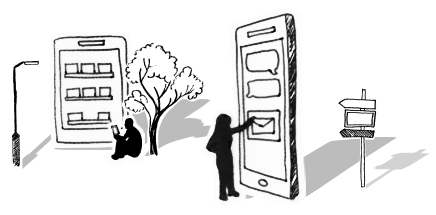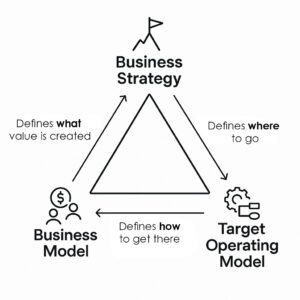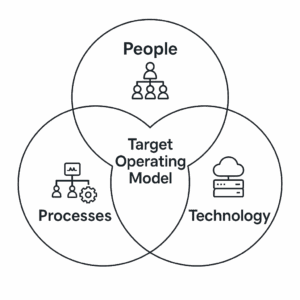




Target Operating Model (TOM): The Complete Guide to Designing, Delivering and Evolving Your Future State
If you’re planning or leading business transformation, you’ve likely encountered the term Target Operating Model. It’s one of those concepts that sounds deceptively simple but carries profound implications for how your business operates, scales and delivers value to customers.
A Target Operating Model is fundamentally your organisation’s blueprint for the future: a detailed vision of how your people, processes and technology will work together to achieve strategic objectives. Unlike your current operating model (COM), which reflects how you work today, or your ‘as-is’ state, a TOM represents where you need to be tomorrow – your ‘to be’. It matters because transformation without this blueprint often leads to fragmented change, wasted resources and strategic misalignment.
Having worked through numerous organisational transformations, we’ve observed time and time again that leaders who invest in understanding and designing robust Target Operating Models consistently achieve better outcomes than those who dive straight into implementation.
So, in this Change 101, we’ll show you:
- What a Target Operating Model is (and what it isn’t)
- The core elements of a TOM
- Use cases and examples of Target Operating Models
- The benefits of a TOM for your transformation, and the challenges of not using one
- Common Target Operating Model pitfalls and mistakes
- Planning, designing, executing and continuously improving your Target Operating Model
- A real-world case study for TOM-powered transformation
What is a Target Operating Model?
Your Target Operating Model is a high-level blueprint of how your organisation will operate in the future to deliver on strategic goals. Think of it as the architectural plan for your business transformation. Where your business strategy defines your destination, your TOM maps the journey.
But here’s where many leaders get confused. So, to clarify the distinctions that matter:
Operating model vs. business model: the “what” and the “how”
Your business model answers fundamental questions about value creation: what value do you offer, to whom and how do you monetise it? It’s your economic logic. Your operating model, however, focuses on operational delivery: how, where, and when that value gets created and delivered.
Consider a SaaS company. Their business model might centre on subscription revenue from cloud-based software. Their operating model defines whether they use agile development teams, how customer support is structured, where data centres are located and how customer onboarding works. The business model is strategic positioning; the operating model is operational reality.
Target Operating Model vs. business strategy: the “where” and the “how”
This distinction proves crucial for transformation success. Your business strategy defines where your business wants to go, be this new markets, competitive positioning or growth targets. Your Target Operating Model defines how your organisation will get there through specific structures, people, processes, and systems.
Strategy without an operating model remains aspiration. An operating model without clear strategic alignment becomes operational drift. You need both, working in harmony.

What are the core elements of a Target Operating Model?
Every effective TOM rests on three foundational pillars, though the specific configuration varies dramatically based on your organisation’s context and strategic objectives.
People: the human architecture
Your people component encompasses organisational structure, roles, responsibilities and culture. Beyond just org charts, this is about how decisions get made, how information flows and how your culture enables or constrains performance.
When designing this element, consider span of control, decision-making authority, skill requirements and cultural behaviours needed for your future state. The most sophisticated technology and processes fail without people equipped and motivated to execute them effectively; this is why People at the Heart is one of our core values!
Processes: the operational workflows
Processes define how work actually gets done. This includes operational workflows, procedures and decision-making frameworks that connect your people with your technology to deliver customer value.
Effective process design balances efficiency with flexibility. You want streamlined operations that can adapt when market conditions shift or when you discover better ways of working.
Technology: the digital foundation
Technology encompasses tools, platforms and IT infrastructure supporting your operations. But here’s what many leaders miss: technology should enable your operating model, not dictate it. Too often, organisations design their operating model around existing technology constraints rather than defining requirements first.

The POLISM framework: a holistic approach
For more granularity, POLISM (Process, Organisation, Location, Information, Suppliers, Management systems) is a popular framework that provides a comprehensive lens for evaluating and designing Target Operating Models.
This framework ensures you consider all operational dimensions rather than focusing only on the most obvious elements. Location decisions, supplier relationships, and information flows often prove more critical to transformation success than initially apparent.
Use cases and examples of TOMs
Target Operating Models may prove valuable for a wide variety of business transformation types and drivers, but here are four key scenarios that many leaders face.
Mergers & Acquisitions
Representing perhaps the most complex TOM challenge, you’re essentially creating a new operating model that integrates people, processes and systems from multiple organisations whilst maintaining business continuity. The complexity multiplies when organisations have different cultures, technologies and operational approaches, so a clear blueprint to bridge the gap between aspiration and reality is critical.
Digital Transformation
Digital transformation initiatives require fundamental shifts from manual to automated or AI-enhanced systems. Your current operating model, designed for human-centric processes, rarely translates directly to digital-first operations. Therefore, you need intentional redesign.
Cost Reduction
Cost reduction programmes benefit enormously from TOM thinking. Rather than across-the-board cuts, you can identify specific operational inefficiencies and redesign processes for optimal cost-effectiveness whilst maintaining service quality.
Business Model Shifts
Moving from product-based to service-based models, for example, demands comprehensive operating model redesign. Your current structure, optimised for manufacturing and distribution, won’t naturally support service delivery and customer relationship management.
A Real-World Transformation: Maersk’s End-to-End Logistics
Maersk’s evolution from a traditional shipping company to an integrated logistics platform represents a masterclass in Target Operating Model redesign. Going further than simply digitising existing operations, the Danish giant fundamentally reimagined how global supply chains could work.
The transformation required dismantling century-old operational silos between shipping, port operations and logistics services. New organisational structures emerged around customer journeys rather than asset types. Technology platforms shifted from managing individual ships to orchestrating entire supply chain ecosystems. Even performance metrics evolved from vessel utilisation rates to end-to-end delivery reliability.
This demanded comprehensive operating model transformation that touched everything from how Maersk hires talent to how they measure success.
Why are Target Operating Models important?
Target Operating Models provide clarity for change initiatives that might otherwise lack focus and direction. When your entire organisation understands the future operating model, decision-making becomes more consistent and strategic alignment improves dramatically. This last benefit is particularly valuable, with strategic clarity being responsible for up to 80% of the difference in performance between businesses.
This clarity translates into improved efficiency, better governance structures and enhanced scalability. Your operations become more intentional rather than simply responsive to immediate pressures, of which businesses today face many and at extremely short notice.
Comparing transformation approaches: with and without a TOM
The difference between transformation with and without a Target Operating Model becomes stark when you examine outcomes:
| With a Target Operating Model | Without a Target Operating Model |
| Strategic alignment ensures change initiatives deliver intended business value rather than just completing projects | Change efforts often fail to deliver expected business value because they lack strategic coherence |
| Increased agility allows your organisation to respond effectively to changing market conditions and competitive pressures | Organisational change becomes static and struggles to adapt to evolving circumstances |
| Operational efficiency improves because you can identify where to prioritise efforts for maximum impact | Identifying where to prioritise for biggest operational gains becomes nearly impossible |
| Employee clarity and engagement increase when people understand their role in the future organisation | Employee resistance to change increases due to uncertainty and lack of clear direction |
| Better customer outcomes result from consistent, well-designed service delivery approaches | Customer experience suffers from inconsistent or unclear service delivery |
By now it should be clear: organisations with clearly defined Target Operating Models can expect to achieve transformation objectives more often and more quickly than those without structured operating model design.
Common TOM pitfalls and mistakes to avoid
The overengineering trap
Many leaders fall into the trap of overengineering their Target Operating Model. They create elaborate frameworks with excessive detail that become unwieldy and impossible to execute effectively. Remember: your TOM should provide clarity and direction, not bureaucratic complexity.
The most effective Target Operating Models balance comprehensiveness with practical usability. They’re detailed enough to guide decision-making but flexible enough to adapt as circumstances change.
Ignoring stakeholder input
Another critical mistake involves designing your TOM in isolation from the people who will actually execute it. Your frontline teams, middle management and key stakeholders possess invaluable insights about operational realities that executive teams often miss.
Stakeholder engagement during TOM design helps achieve buy-in, but it also builds a more robust and realistic operating model that acknowledges practical constraints and opportunities.
Failing to account for culture
Organisational culture either enables or constrains your Target Operating Model’s effectiveness. Many transformations fail because leaders underestimate cultural barriers to new ways of working.
Your TOM must align with your cultural strengths and explicitly address cultural gaps that could impede implementation. This means honest assessment of current cultural norms and intentional strategies for cultural evolution.
The one-size-fits-all fallacy
Perhaps the most dangerous assumption is treating Target Operating Models as universal solutions that can be copied from other organisations or applied uniformly across different business units.
Every organisation has unique strategic objectives, competitive contexts, and operational constraints. Your TOM must reflect these specificities rather than following generic templates. Beware of experts telling you their approach is the only correct one!
“Organisations with clearly defined Target Operating Models can expect to achieve transformation objectives more often and more quickly than those without structured operating model design.”
How to plan your Target Operating Model
There are four key steps to planning a Target Operating Model:
- Ensuring strategic alignment
- Securing leadership buy-in
- Analysing your current state
- Determining how to close the gaps to your future state
Ensuring strategic alignment
Before designing any operational elements, you must anchor your Target Operating Model firmly in business strategy. This alignment ensures that operational decisions support strategic objectives rather than contradict them. As mentioned, your business strategy determines where you’re going, and your TOM is how you’ll get there. Not aligning your TOM to your strategy is like piloting a plane without knowing the destination before take-off.
Strategic alignment requires clear understanding of your business strategy’s key priorities, competitive positioning and success metrics. Your TOM should demonstrably enable these strategic elements.
Securing leadership buy-in
Early executive sponsorship is absolutely critical for TOM success. Without genuine leadership commitment, transformation initiatives face resource constraints, competing priorities, and organisational resistance that can derail even well-designed operating models.
Genuine leadership buy-in means more than approval, requiring active sponsorship, resource allocation and consistent messaging about transformation priorities.
Current state analysis
Understanding your starting point enables more effective TOM design. This analysis should include a comprehensive assessment using proven frameworks. Examples include:
- SWOT analysis: Identifies your organisation’s strengths, weaknesses, opportunities and threats relative to your strategic objectives. This analysis reveals which current capabilities to preserve and which gaps to address through your Target Operating Model.
- PESTLE Analysis: Examines Political, Economic, Social, Technological, Legal and Environmental factors that could impact your operating model effectiveness. These external factors often influence operational design decisions more than internal considerations.
- Stakeholder input: Perhaps the most insightful data will come from speaking to your people. Capture needs, pain points and success stories from people across your organisation. This qualitative data complements analytical frameworks with practical insights about operational realities.
Gap analysis and roadmap planning
Conduct gap analysis to identify specific differences between current state and desired future state across all operational dimensions. This analysis forms the foundation for prioritisation and sequencing decisions.
From this information, you can plan and scope your TOM transformation, defining clear boundaries, realistic timing and appropriate team structures for execution. The roadmap should balance transformation ambition with operational continuity requirements.
How to design your Target Operating Model
The key areas you should consider when designing your Target Operating Model are:
- Your North Star vision
- Functional or departmental goals
- Governance structures
- Risk mitigation
- Embedding agility
- Priority areas
- Your success metrics
North Star vision
Your transformation needs a clear, concise vision that reflects the desired future state and guides all operational design decisions. This North Star serves as your reference point for maintaining strategic focus across teams and transformation phases.
The most effective vision statements combine inspirational elements with practical specificity. They should motivate your organisation whilst providing concrete direction for operational choices.
Functional goals
Translate your vision into specific functional goals that define success for each operational area. These goals should align directly with your North Star and will address unique requirements for different business functions. However, examples might include:
- Customer experience: Improve response times and resolution rates
- Operations: Streamline processes and reduce operational costs
- Technology: Modernise infrastructure and improve system reliability
- HR: Develop new capabilities and accelerate decision-making
- Finance: Enhance reporting accuracy and speed financial processes
- Supply chain: Increase visibility and optimise inventory management
Governance
Governance structures prove crucial for transformation success. You need clear frameworks for decision-making, accountability and escalation that enable effective coordination without creating bureaucratic delays.
Risk mitigation
Every Target Operating Model faces implementation risks that could derail transformation success. Identify these risks early and build specific contingencies into your operating model design.
Agility
Simultaneously, ensure your TOM maintains sufficient agility to adapt as circumstances change. Rigid operating models often fail when market conditions shift or when implementation reveals unexpected challenges.
Prioritisation
Phased implementation based on unlocking maximum business value allows you to demonstrate early wins whilst building capability for your more complex transformation elements. This approach reduces risk whilst maintaining transformation momentum.
Success Metrics
Define specific KPIs for tracking progress and measuring impact. These metrics should reflect both operational efficiency improvements and strategic objective achievement.
How to execute your Target Operating Model
Your TOM only provides value when it is achieved. The steps you can take for seamless TOM realisation are:
- Develop a clear roadmap
- Maintain a people-first focus
- Deliver compelling communications
- Create a champions network
- Upskill through training
Develop a clear roadmap
Transform your TOM design into a time-based plan of action with clear milestones and accountability structures. Your roadmap should balance transformation pace with change management capacity. Transparently articulating your journey will help your people engage and trust in it, reducing resistance.
Effective roadmaps include dependencies, resource requirements and contingency plans for addressing implementation challenges. They will also include concrete phases or milestones to drive momentum and create opportunities for celebrating successful progress.
Put people at the heart
Successful TOM execution requires equal investment in human aspects throughout the transformation process. Technology and process often receive the lion’s share of attention from leaders and in communications, but any change will fail if people aren’t equipped and motivated to execute the new ways of working required of them. Put them first throughout, even if your transformation takes years, as is often the case with TOMs.
Deliver compelling communications
Communication strategies should provide transparent, frequent updates about transformation progress, challenges and successes. Regular communication builds confidence and maintains engagement during inevitable transformation difficulties. Comms should be creative and engaging to stand out from other initiatives vying for attention, and they should be aligned to your North Star vision to tell the story of your transformation and nurture an emotional connection to it.
Create a champions network
Champions and Sponsors throughout your organisation can model new behaviours and influence peer adoption. These influencers often prove more effective than formal change management programmes for driving cultural shifts, so engage them early and seek their input at all stages.
Upskill through training
Training (hard skills) and learning (mindset shift) initiatives must equip your people with skills and knowledge required for your future operating model. This includes both technical capabilities and soft skills for working in new organisational structures. No matter how engaged and excited about your transformation people are, there’s no way for them to adopt and sustain it if they don’t know how.
Can a Target Operating Model ever be ‘finished’?
A Target Operating Model can take years to implement, so it should be agile and dynamic, evolving alongside your organisation and the internal and external influences that shape it over the course of the journey. Therefore, it’s hard to definitively achieve or complete your Target Operating Model; instead, your mindset should be about adapting and continuously improving it through:
- KPIs and performance monitoring
- Feedback loops and organisational learning
- Adaptive evolution
- Benefit realisation and value creation
KPIs and performance monitoring
Your Target Operating Model demands rigorous performance measurement that goes beyond traditional operational metrics. The challenge lies in selecting metrics that genuinely reflect TOM effectiveness rather than just operational activity. We’ve observed organisations that meticulously track dozens of KPIs whilst missing fundamental shifts in their competitive position or customer needs. The most valuable metrics often emerge from understanding the specific value drivers within your transformed operating model.
Establish regular review cadences that balance comprehensive analysis with actionable insights. These reviews should examine metric trends, identify emerging patterns, and surface early warning signals about potential operational challenges.
Feedback loops and organisational learning
Feedback from users, teams and stakeholders provides qualitative insights that quantitative metrics cannot capture. Frontline employees often identify operational friction points, process improvements and customer insights that remain invisible to management dashboards.
Design feedback mechanisms that encourage honest input rather than politically acceptable responses. Anonymous surveys, cross-functional retrospectives and structured listening sessions can reveal operational realities that differ significantly from official performance reports. The key is creating psychological safety for people to share genuine observations about what’s working and what isn’t.
As importantly, establish clear processes for translating feedback into operational adjustments that demonstrate genuine responsiveness to organisational learning.
Adaptive evolution
Market conditions, competitive dynamics and internal capabilities evolve continuously, requiring corresponding adjustments to your Target Operating Model.
Develop environmental scanning capabilities that identify relevant changes in technology, regulation, customer behaviour and competitive landscape. These insights should inform regular TOM review processes that assess whether current operational design remains optimal for achieving strategic objectives. Sometimes external changes create opportunities for operational enhancement; other times they demand defensive adjustments to maintain competitive position.
Benefit realisation and value creation
Transformation success requires ongoing validation that your Target Operating Model continues delivering expected business value. This assessment should examine both quantitative performance improvements and qualitative changes in organisational capability, market positioning and competitive responsiveness.
Document and communicate transformation successes to maintain organisational commitment and identify opportunities for further enhancement. Success stories build confidence for additional change initiatives whilst revealing principles and practices that can be applied to future operational improvements.
Target Operating Model case study: Transforming the NHS’s largest flexible workforce provider

In response to exponential growth during the COVID-19 pandemic, the UK’s largest NHS flexible staff bank faced a pressing challenge: an outdated and overly complex operating system that could no longer meet the increasing demands of over 50 NHS Trusts and 180,000 bank members. The organisation recognised the need for a bold, strategic transformation to become the workforce partner of choice for the health and care sector.This would require more than new technology and processes; it needed a fundamental shift in culture and ways of working.
Working closely with the client, we co-designed a future-focused Target Operating Model grounded in purpose, clarity and people-first thinking. Through a series of in-depth TOM workshops, we reimagined their operating structure across people, processes, technology and data. Alongside this, we embedded sustainable change capabilities, introduced business process governance and equipped internal teams with the toolkits and skills needed to lead their own transformation. With ADKAR methodology rolled out across major programmes and change champions engaged throughout, the client is now firmly on the path toward becoming a strategic and resilient force in UK healthcare workforce solutions, putting more people in more places to care, faster.
Go behind the scenes of successful TOM-driven transformation and read the full case study here.
Emerging trends in Target Operating Models
AI integration and automation
Artificial intelligence and automation technologies are enabling new forms of operational excellence that weren’t previously possible. AI integration affects not just individual processes but entire operational approaches to customer interaction, decision support and work coordination.
The most forward-thinking organisations are designing Target Operating Models that assume deep AI adoption rather than treating it as an add-on to existing processes.
Decentralisation and flexibility
Remote and hybrid work models are driving more decentralised and flexible operating model designs. Traditional hierarchical structures are giving way to flatter, more networked organisational forms that enable faster decision-making and greater employee autonomy.
This trend requires rethinking traditional assumptions about management span of control, coordination mechanisms and performance measurement approaches.
Sustainability integration
75% of leaders acknowledge that sustainability drives better business performance, and as such environmental and social goals are becoming integral to operating model design rather than separate corporate responsibility initiatives. Organisations are embedding sustainability metrics into operational processes and decision-making frameworks.
This integration affects supplier relationships, location decisions, technology choices and performance measurement systems across the entire organisation.
Moving forward with your Target Operating Model
Your Target Operating Model represents one of the most powerful tools available for organisational transformation. When designed thoughtfully and executed systematically, it provides the blueprint for achieving strategic objectives whilst maintaining operational excellence.
The key insight from our experience working with transformation initiatives is that success depends more on disciplined execution of TOM principles than on sophisticated theoretical frameworks. Start with clear strategic alignment, engage your stakeholders authentically and maintain focus on practical implementation over elaborate planning.
Your organisation’s future effectiveness depends on how well you can translate strategic vision into operational reality. A well-designed Target Operating Model bridges that gap, providing the structure and clarity needed for transformation success.
If you need any support defining or delivering your Target Operating Model and the change required to realise it, get in touch with our expert team today.
Frequently Asked Questions about Resistance to Change
A Target Operating Model (TOM) is a high-level blueprint of how an organisation will operate in the future to deliver its strategy. It defines how people, processes and technology will work together to achieve business goals, bridging the gap between strategy and execution.
To build a Target Operating Model, align it with your business strategy, analyse your current state, identify capability gaps and design future-state structures, processes and systems. Create a clear roadmap, engage stakeholders and implement with ongoing feedback and performance tracking.
A Target Operating Model should be detailed enough to guide decision-making and implementation, but flexible enough to adapt over time. It should clearly define roles, processes, technology, governance and success metrics, without becoming overly complex or rigid.
An Agile Target Operating Model incorporates agile principles into organisational design. It focuses on cross-functional teams, rapid iteration, decentralised decision-making and continuous improvement, enabling businesses to adapt quickly to change while delivering customer value.
A Target Operating Model roadmap is a structured plan that outlines how the organisation will transition from its current state to its future state. It includes milestones, phases, dependencies and change management activities needed to implement the TOM successfully.
Common challenges include resistance to change, lack of strategic alignment, overcomplicated designs and cultural misfit. Without stakeholder input and leadership buy-in, TOMs can become theoretical exercises rather than practical tools for transformation.
A business model defines what value an organisation creates and how it monetises it. An operating model defines how that value is delivered, covering the people, processes, technology and systems required to operate effectively.
An operating model reflects how the organisation functions today. A target operating model (TOM) describes how it intends to operate in the future to achieve strategic objectives. TOMs guide transformation by mapping the journey from current to future state.
A business strategy sets out where the organisation wants to go; its goals and priorities. A Target Operating Model defines how the organisation will get there, outlining the structures, systems and ways of working needed to deliver the strategy.
A Target Operating Model (TOM) provides clarity, structure and alignment for business transformation. It ensures that strategic goals are translated into practical operations by defining how people, processes and technology will work together to deliver value. Without a TOM, change efforts often lack focus, waste resources and fail to achieve intended outcomes.
Implementing a Target Operating Model can take months to several years, depending on the size, complexity and scope of transformation. A phased approach, prioritising early wins while maintaining long-term momentum, is often recommended to balance ambition with operational continuity.
Designing a Target Operating Model typically involves senior leadership, strategy teams and functional heads, with input from change managers, architects and frontline stakeholders. Executive sponsorship is essential, but collaborative design ensures the model is realistic, aligned and supported across the organisation.
Yes, a Target Operating Model should be treated as a living framework. It evolves in response to internal growth, market shifts, new technologies or strategic pivots. Continuous improvement, regular reviews and stakeholder feedback help ensure the TOM remains aligned and effective.
Common frameworks for designing a Target Operating Model include POLISM (Process, Organisation, Location, Information, Suppliers, Management systems), business capability mapping, and governance models. These tools help ensure comprehensive design across all operational dimensions.
A Target Operating Model supports digital transformation by redefining how the organisation operates in a digital-first world. It aligns people, processes and technology to support automation, agility and data-driven decision-making, enabling a smooth shift from legacy systems to modern, scalable operations.
To get the latest change tips, advice and guidance directly to your inbox, sign up to our monthly Business Change Digest.
